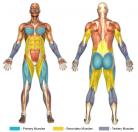Squat Thrusts / Up-Downs (Dumbbell)
- Stand with a dumbbell of desired weight grasped and held at each of your sides (keeping in mind that you will be performing a series of squats with them).
- Begin by squatting downward until you reach a crouching position, place a dumbbell on the ground at each of your sides (about shoulder-width or wider apart) with the dumbbells grasped with a neutral grip (i.e. palms facing inward), keep your arms extended beneath you, and then extend your legs outward behind you (with your feet touching or slightly apart), inhaling throughout the motion. (You will now be in the "top/up" aspect of a push-up position.)
- Continuing to inhale, lower your torso by bending at your elbows until your chest/rib cage is near the ground.
- In a single contiguous motion, begin to exhale, press until your arms are nearly extended and then bring your knees to your chest while rotating your torso upright so that your feet are beneath you (you will be in a squatting position).
- Continuing to exhale, perform an upward squat (maintaining a dumbbell in each of your hands), and return to an upright, standing position. (You have now completed 1 full repetition).
- Repeat steps 2-5 for as many repetitions as are desired.
Squat thrusts / up-downs may be performed using a barbell; however, some individuals, especially those not accustomed to performing deadlifts, may find it substantially more difficult to balance when using a barbell because the weight cannot be shifted forward or backward as easily to aid in maintaining balance as it can with dumbbells.
Remember, as with all squatting exercises, to maintain knee and feet alignment as much as possible. For some this will be achieved by pointing the feet directly forward and for others the feet may point outward--at least to some degree. If you are not sure which way best suits you, simply note the manner in which you walk. If your natural gait has your feet pointing outward, then that's probably the best position for you. Also, note that it's inevitable that during the squatting motion the feet and knees won't maintain exact alignment; this is okay. However, as always, do keep proper, disciplined form in mind, and, if necessary, experiment to see which foot placement best suits your unique physical structure.
Be especially sure to keep your core muscles tightened when performing the squat to help avoid back injuries.





